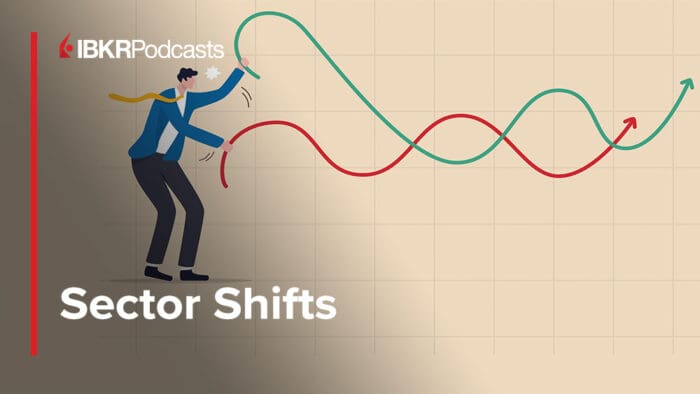Join us as Gary Christie from Trading Central delves into the current state of the U.S. stock market. Discover which sectors are driving the market, the impact of recent earnings, and the rotation from large cap to small cap stocks and get an in-depth look at the technical tools that can help you navigate these turbulent times.
Summary – IBKR Podcasts Ep. 179
The following is a summary of a live audio recording and may contain errors in spelling or grammar. Although IBKR has edited for clarity no material changes have been made.
Andrew Wilkinson
In this week’s episode, I’m delighted to welcome Gary Christie from Trading Central to take a look at the health of the U. S. stock market from the perspective of a technical analyst. Welcome, Gary. How are you?
Gary Christie
Fantastic Andrew. Thanks. How you been?
Andrew Wilkinson
I’m doing all right. Thank you. So you’re joining us at a time when the broad market has stalled, perhaps at all-time highs.
Within the churn, what sectors or individual names are currently driving the market?
Gary Christie
Yes. It’s been some interesting times in the market. AI stocks have fallen out of favor over the last few weeks. Primarily we think due to some high valuations compared to the small cap stocks and really looking at the markets last week, the major indices were really under pressure, following really some economic data that surprised investors, right?
Disappointing quarterly earnings from key companies also affected the market. So we’re looking at declines of over 1.5% in the S&P last week.
NASDAQ also tumbled over 2.6% percent. Just wild. But the Russell gained almost 2%. That’s telling an interesting story and a rotation happening in the market, right?
So again, key economic data has also been a driving factor. We had core PCE last week, which measures the prices paid by consumers for goods and services, excluding food and energy, it rose by 2. 6 percent year over year, above estimates, and GDP also grew by 2.8%, also above estimates, compared to about, I think it was 1.4% in the prior quarter, so we see some strength in the economy.
Inflation is still a subject matter and a concern. So overall, while strong GDP growth supports a positive outlook for the economy, inflation concerns are obviously going to remain, right? So, what sectors have been moving, right?
So what have we seen last week? Consumer discretionary technology and communication services were the biggest underperformers of the week. While healthcare utilities and materials emerge as the big leaders, right? So despite a strong healthcare sector, we’ve seen some massive moves certain stocks, medical device maker Dexcom tumbled over 42% cutting its full year sales outlook.
Edwards Life Sciences also dropped over 28% last week as their quarterly sales missed estimates. Big names are also dropping the market, right? Ford sank over 22% on earnings that disappointed investors as well. Tesla. Big subject matter, big talk of the town. Dropped over 11% on disappointing earnings again.
As well as Alphabet, also declined on YouTube advertising revenue. That declined. Missed estimates and Ford also dove. So there was some big moves in earnings and we’re into the prime earning season right now. Lots of big names coming out, which we’ll talk about later on this week, but always have been major drivers in this rotation we’ve seen from large cap to small cap.
Andrew Wilkinson
Let’s talk about that. Weigh in, if you will, on the rotation that’s taking place from large cap tech to the small cap names. And can you explain to the audience happening and whether or not it’s a healthy move, Gary?
Gary Christie
Yeah. Great question. Great question. So of course we’ve seen a notable shift over the last three weeks, specifically from mega caps into small caps. And one can use, we do on our desk, we use the relative rotation graph. And we look at the Russell 2000 index over the last three to four weeks. We can clearly see healthcare, financial, real estate, and telecom stocks have been the outperformers, right? This shift has been both healthy and concerning in some aspects, right?
So on the healthy side, it really indicates investor diversification, broader market participation, settling really a more inclusive economic recovery, right? And continuation. But on the flip side, too, increased investment in small caps, So just some risk involved in terms of volatility, right?
So although, we’re seeing that rotation being more broad, it’s in more risky or smaller names. And we like to see a more balanced market with healthy participation from both small caps and mega cap stocks, which we think is really essential for sustained economic growth.
We can compare the S&P 500 against the Russell 2000 index in a ratio chart, and we can see that on a weekly chart of this ratio, a fast decline over the last three weeks, but we’re nearing this long rising uptrend and support line.
So although we’ve seen clearly broad market participation because of small caps coming into favor, we’re at this almost this tipping point of do we see rotation back into tech in the next week or so? Because we’re on this rising supporting trend line or this bullish channel where large cap stocks have always out favored and outperformed small cap counterparts, right?
So, what we want to see this week is, what happens from earnings this week? We have some key drivers of tech earnings coming up. Is that going to flip? Or do we break down and have this big disparity between small caps and large caps where we see continued outperformance of small caps? So, although again, we like a more broad participation, only a few names have been driving the market lower in terms of the S&P and NASDAQ.
Some of these big AI stocks like the NVIDIA s and of course Tesla we talked about. Is it temporary or not? I think it’s a little too early to tell. Again, is it really healthy how the market’s been reacting? Also, I think it’s really too early to tell until we pass this earning season to see what really happens.
But it’s an interesting dynamic, of course, we’ve been watching closely.
Andrew Wilkinson
Gary, what particular technical tools are working well under current conditions and maybe why?
Gary Christie
Yeah, so in the current market environment, certain tools we use have been particularly effective. Moving averages, such as the 20, 50, and 200 day, and it could be week as well in weekly chart, have been excellent identifying confirming trend directions. Really the longer-term trend that that we focus on the most, the better on a weekly chart down to daily, then intraday.
But really, on a daily chart of the S&P 500 index, right? I have it right in front of me right now. Actually, I’m always looking at it. We’ve been stuck in between the 20 and 50 day moving average. So we broke below that 20 day moving average. That’s been a quick signal that the market’s short term bearish.
And now, we’ll look to get back along the index and look to get back long stocks in the S&P 500 when we break back above it. But for now, we’re in this in between zone where short term is very bea rish, but long term, the trend is still intact in a bullish overall market, right? So moving averages are key for us to give us a quick signal of short term versus long term.
Where does the trend lie? And then oscillators such as the Relative Strength Index, RSI is one that we use a lot at Trading Central on all our charts, actually, to really help us spot overbought or oversold conditions.
And looking at the S&P on a daily chart, the last two instances where the RSI was considered oversold near at 30 level and rebounded back above its median 50 level, it signaled a new uptrend, or at least a continuation of the prior uptrend.
So we’re almost there now. So we’re not really considered even completely oversold yet, but that indicator when we’re patient, we wait for it to happen to hit that 30 level. That could be a great signal to wait to allocate capital to the markets and look for new long opportunities. On top of that, support and resistance levels really formulate our trading plans.
So we are constantly scouting the market, looking for major trading levels of support and resistance, and we draw them right on our charts. And then we wait and wait for alerts to activate those reversals.
Andrew Wilkinson
So Gary, it still sounds like you’re very constructive about the markets. Are you seeing any warning signs about negative move in the market going forward?
Gary Christie
Interesting, Andrew. Yes. So now, we’re in that holding pattern. So although it’s looking really ugly, especially today, as we talked, the market’s looking under more pressure right now, still above a rising trend line in SPX, earnings are going to be critical this week. We got Microsoft coming up Tuesday.
We got Meta, Amazon, Apple this week, all big players that really set the tone for the market going forward, we believe. So, Looking at, the SPX on a daily chart right now, short term, yes, we’re bearish below that key resistance level of 55-10 ish area, right? That’s like, a key support level that’s broken down below this rising trend line that’s been in place since May, really, and we’re below that right now, and now we’re currently testing that 50-day moving average on the downside.
So, so it’s, overall, we’re looking quite weak. And I think earnings are going to tell us a different story, or at least set the tone this week. It’s so important. But for now, we’re being very cautious because the trend is in fact bearish on the short term.
And the long term is giving us mixed signals. Do we hold above support right now or not? And that’s around that 53-40 SPX level is what we’re watching on the downside to see if we can bounce off that, and resume the prior uptrend. But it’s a little too early to tell right now.
Andrew Wilkinson
So you mentioned a lot of fundamental elements there within your analysis, Gary, but how does a technical analyst deal with fundamental events including the November U. S. election?
Gary Christie
Ah yes, interesting yes. So, we think it’s all about risk management, right? So having, as I just talked about, your support and resistance levels clearly identified on your charts with automated alerts being ready when levels hit certain price points and reversals. And all that is really critical, in our opinion, right now.
Also having a trading plan really helps us for these volatile, fundamental events, right? Also, maintaining emotional discipline, alright? And sticking to my trading plan, for me personally, helps navigate all this heightened market emotion and really help us deal with these fundamental events coming up.
Because all you can really rely on as a technical analyst, anyway, is the price action, right? And there’s little things you can do to prepare yourself. Cutting position size. And trading smaller into major fundamental events, such as earnings, economic releases, and of course, the upcoming election, really helps us protect against any uncertainty and market volatility. Also really being aware of what sectors depending on which political party is in power really also helps us, in terms of risk management standpoint.
So looking at the upcoming election, usually under Republican administrations, sectors such as energy, particularly oil and gas, financial services, defense and aerospace, industrials and certain segments of healthcare tend to do well. This is really due to policies emphasizing deregulation, tax cuts and increased defense spending.
Now, on the other hand, Democratic administrations often really favor sectors like renewable energy, technology, healthcare as well, some versions of it, consumer, discretionary and clean utilities. So really, policies focusing on environmental protection, renewable energy incentives, healthcare expansion, technology infrastructure, really tend to benefit these sectors, right?
So, again, for example, renewable energy companies including those in solar and wind often see a boost under Democratic leadership due to increased subsidies and support for clean energy initiatives.
Conversely, really traditional energy sectors like oil and gas really may benefit from Republican policies that really reduce regulatory burdens and promote fossil fuel production.
Andrew Wilkinson
Gary, the financial sector seems to be holding up remarkably well. Is there a reason for that at this point?
Gary Christie
So, really, I think it all comes down to rates. I know we have a big rate decision coming in this week. It’s been higher for longer, we think. The expectation of it dropping so fast never really happened and I think that’s really going to help financials in the long run with the current rate environment.
So I think it’s really been a rate story and the Russell Index really makes up a majority of the financial companies, right? What we’ve seen is an acceleration and outperformance of the Russell 2000 index over the SPX on a ratio chart. We’ve seen that. Break it down. Financial stocks have been outperforming. I think it’s really the rates, you know? The rate decision is coming up and if you remain here for longer, that will benefit some financials at the expense of these large-cap tech stocks, especially in the AI universe.
Andrew Wilkinson
Thank you very much to Gary Christie, Head of North American Research with Trading Central, for joining me in this episode. Look out for additional episodes from us at IBKR Podcasts, and don’t forget to subscribe wherever you download your podcasts from.
Join The Conversation
For specific platform feedback and suggestions, please submit it directly to our team using these instructions.
If you have an account-specific question or concern, please reach out to Client Services.
We encourage you to look through our FAQs before posting. Your question may already be covered!
Leave a Reply
Disclosure: Interactive Brokers
The analysis in this material is provided for information only and is not and should not be construed as an offer to sell or the solicitation of an offer to buy any security. To the extent that this material discusses general market activity, industry or sector trends or other broad-based economic or political conditions, it should not be construed as research or investment advice. To the extent that it includes references to specific securities, commodities, currencies, or other instruments, those references do not constitute a recommendation by IBKR to buy, sell or hold such investments. This material does not and is not intended to take into account the particular financial conditions, investment objectives or requirements of individual customers. Before acting on this material, you should consider whether it is suitable for your particular circumstances and, as necessary, seek professional advice.
The views and opinions expressed herein are those of the author and do not necessarily reflect the views of Interactive Brokers, its affiliates, or its employees.
















Something is not right with this podcast. The IBKRCampus Podcast page is dated August 1. Gary Chirstie talks about Microsoft earnings as they are yet to happen. The Podcast file is from 3 days ago. Microsoft earnings occurred July 28th. Can someone make some sense of this.
Hi Harry, thanks for commenting. IBKR Campus attempts to produce and update our materials as quickly as possible. Please note that our fastest standard production turnaround time is one day.